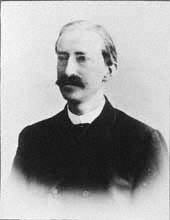George Arnold Escher
George Arnold Escher | |
|---|---|
 | |
| Born | May 10, 1843 |
| Died | June 14, 1939 (aged 96) |
| Nationality | Dutch |
| Occupation | civil engineer |
George Arnold Escher (10 May 1843 – 14 June 1939) was a Dutch civil engineer and a foreign advisor to the Japanese government during the Meiji period.[1]
He was the father of the graphic artist M. C. Escher and the geologist Berend George Escher.
Career
Escher was hired by the Japanese government as a foreign advisor from September 1873 to July 1878, along with fellow Dutch civil engineers Johannis de Rijke and C.J. van Doorn.[1] During his stay in Japan, he designed and supervised the restoration of the Yodo river (Osaka), and built a harbour in Mikuni in Fukui prefecture.
After returning to the Netherlands, he worked in Maastricht. During this time, he recorded in his diary his difficulty as a Protestant in finding a suitable marriage partner in Roman Catholic Maastricht who would also be able to satisfy his equation v = 1/2m + 10, where v was the age of the woman, and to the age of the husband. [2] In 1882, Escher married Charlotte Marie Hartitzsch, with whom he had two sons. He became a widower in 1885, and in 1892 married Sara Gleichman, with whom he had three more sons. Escher worked as a hydraulic engineer in Leeuwarden. In 1903 the family moved to Arnhem.
Notes
- ^ a b Louman, Johannes. (2007). Fries waterstaatsbestuur, p. 127., p. 127, at Google Books
- ^ v = 1/2m + 10
References
- Kamibayashi, Yoshiyuki. "Two Dutch Engineers and Improvements of Public Works in Japan," Proceedings of the Third International Congress on Construction History, Cottbus, May 2009.
- Louman, Johannes Petrus Antonius. (2007). Fries waterstaatsbestuur: : een geschiedenis van de waterbeheersing in Friesland vanaf het midden van de achttiende eeuw tot omstreeks 1970. Amsterdam: Amsterdam University Press. OCLC 150391614
